The Limits of Community Policing
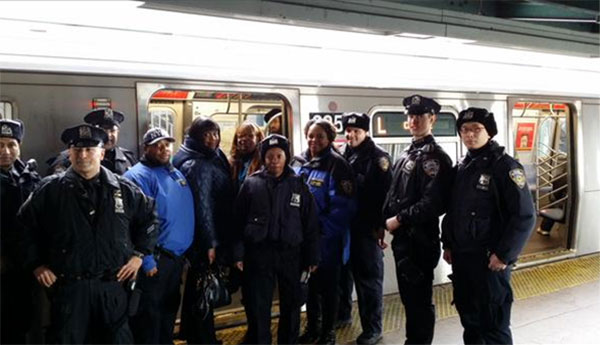
NYPD Transit (photo: @NYPDLTrain)
We share many of the recent concerns about overly aggressive, discourteous, and unlawful policing that have been raised in the last several months. Every day hundreds of mostly poor and non-white New Yorkers have unwanted and problematic interactions with the police including unjustified stops and illegal searches, frequent issuances of summonses for non-criminal behavior, and harassment and intimidation by police. Therefore we applaud the holding of a hearing Tuesday by the Public Safety Committee of the New York City Council on improving policing. There is a need for major reforms in how policing is conducted in New York City.
We are very concerned, however, that the leadership of both the NYPD and the City Council are proposing to add 1,000 police officers to the NYPD headcount under the guise of expanding community policing. Too often, community policing means more intensive and invasive policing of minor disorderly behavior that serves to criminalize mostly people of color without dealing with the underlying causes of this behavior like poverty, homelessness, problematic drug use, mental health issues, and more.
The majority of New Yorkers are not actively engaged in the political life of their local neighborhood. Some may be politically active in other venues, others may be focused on national or international concerns, and most are caught up in the daily struggles of home and work.
Part of the problem with so-called community policing lies in the nature of community. Those who are active in community affairs are not always representative of the full diversity of views and experiences in our many neighborhoods. Community Boards and Precinct Community Councils tend to be populated by long-time residents, those that own rather than rent their homes, business owners, and landlords. The views of renters, youth, homeless people, and the most socially marginalized are rarely represented in these bodies.
Community policing tends to turn all neighborhood problems into police problems. Across the country, community police programs have been based on the idea that the community should bring its myriad of concerns about the condition of the community to the police, who will work with them on developing solutions. Invariably, however, the range of community problems extends far beyond serious crime. Why should the police necessarily be the sole or even lead agency in developing strategies to address community concerns about disorder and public safety?
One of the most frequent concerns of neighborhood residents is the presence of low level drug dealing and use. This generates a tremendous number of calls to 311 and 911. Enhancing the ability of police to respond to these community concerns will just further criminalize people involved with low level drug use and sales. The failed "War on Drugs" strategy of criminalizing these activities has done nothing to reduce the availability and negative effects of drugs on individuals or communities, has produced substantial negative collateral consequences for those arrested, and has been a major drain on city resources. The cost of running each bed at Rikers Island comes to over $150,000 a year; money better spent on prevention, harm reduction, treatment, and jobs programs.
There is extensive research that shows that most complaints that "community representatives" take to the police are about "quality of life" problems rather than serious crime. People tend to raise concerns about local disorderly conditions such as noise and traffic, or public behaviors they find annoying such as small-time drug dealing, prostitution, and any gatherings of young people. More intensive police attention to these "community" concerns will invariably lead to further unnecessary and counterproductive harassment and criminalization of many of New York's poorest and most vulnerable.
As an example, at a recent 67th Precinct Community Council meeting in Flatbush, Brooklyn the main complaint of community members was the regular presence of homeless people in and around businesses at the corner of Church and Nostrand Avenues. Some of these people had obvious mental health problems and others panhandled for money for subsistence purposes. The local police commander pledged to respond to these concerns but acknowledged limited capacity and resources to do so. Increased police responsiveness to these complaints, in the absence of new services, will lead to the harassment and arrest of these people in the name of community policing. This is not the kind of improved policing we need.
To the extent that police need to be involved in managing quality of life community concerns, it should be restricted to responding to truly dangerous conditions. The police could also play a role as gatekeeper to enhanced services, such as how Seattle's Law Enforcement Assisted Diversion (LEAD) program diverts low-level drug offenders and sex workers to social services instead of jail. For too long the city has over-relied on the police as first responders to a range of community concerns that might better be dealt with through other city agencies. The police primarily have punitive tools at their disposal, such as arrest and the use of force. What is needed instead are responses that are less punitive and provide real pathways out of addiction, joblessness, homelessness, and poor health.
We do want the police to be more courteous, professional, and respectful, but expanding the ability of police to respond to community concerns will lead to more criminalization of people trying to survive when their most basic needs are not being met. Therefore, we oppose any increase in the number of police at this time and instead call on the City Council to use whatever resources it would have used to increase the headcount of the NYPD to instead invest in supportive housing, harm reduction programs, evidence-based drug treatment, and health services that can play a much more positive and sustained role in reducing very real community concerns about disorder and public safety.
***
by Alyssa Aguilera and Alex S. Vitale
Aguilera is Political Director at VOCAL-NY.
Vitale is Associate Professor of Sociology at Brooklyn College and author of City of Disorder: How the Quality of Life Campaign Transformed New York Politics.
***
Have an op-ed idea or submission for Gotham Gazette? E-mail editor Ben Max: This email address is being protected from spambots. You need JavaScript enabled to view it.
A Short-Sighted Garbage Plan
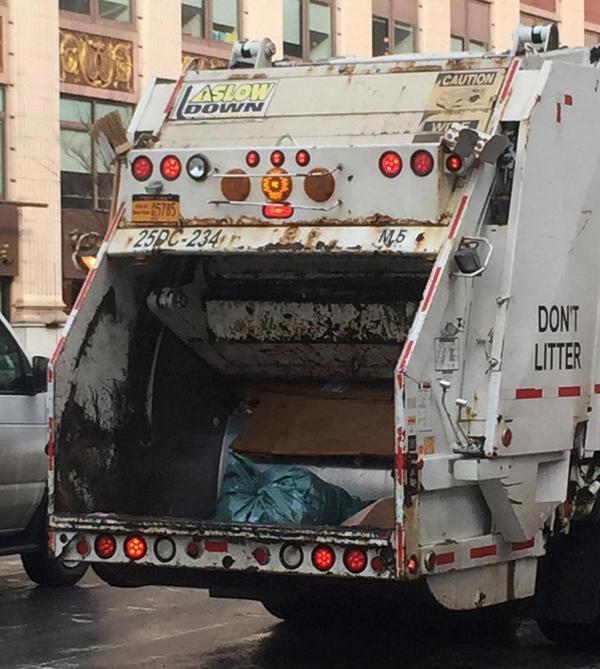
(photo: @wasterecycling)
Effective management of waste is a topic that concerns many individuals, community leaders, and business organizations, especially when new proposals presented in the City Council threaten hard-earned jobs in the waste and recycling industry.
On February 13, union workers, city council members, business leaders, and waste industry experts joined forces to oppose Intro. 495, a proposal that seeks to reduce waste transfer station capacity in select neighborhoods in New York City.
The idea behind the legislation is attractive, but naïve, as it simply glazes over current problems without providing real waste and recycling processing solutions. The proposal aims not to reduce waste, but simply to distribute it to different neighborhoods in the city. In doing this, Intro. 495 actually adds truck miles throughout the city as sanitation trucks will have to travel further to these alternative transfer stations, and will result in higher costs for New York City businesses.
Proposals like Intro. 495 would also destroy good-paying jobs. Despite claims from opposing parties, private waste companies are required by federal, state, and city law to ensure their trucks are in good working order for their trained workers and the communities they serve. Intro. 495 would eliminate many jobs in a workforce predominantly composed of people of color. These opposing parties are unions that represent a tiny fraction of the private sector waste industry, and are trying to use Intro. 495 to further their own interest while harming the majority of workers who would be adversely affected by this ill-conceived plan.
New York City produces more than 35,000 tons of waste every day. Were the marine transfer stations called for in the plan to open, around 5,700 tons per day would be diverted to these facilities. As a result, more than 400 trucks per day would be redirected from areas targeted by Intro. 495. These are part of the City's Solid Waste Management Plan, which is in the process of being implemented. We firmly believe careful planning and measurement should be a priority before passing laws that will adversely affect communities, jobs, and our environment.
Waste workers work when it's sunny, raining, or blistering cold outside. They don't get a "day off" when natural disasters hit our fast-paced city. They quickly respond to emergencies in order to keep New York City open for residents and commuters. The transfer stations targeted by Intro. 495 played a crucial role in managing debris after Superstorm Sandy, and this capacity would not be available if the bill is enacted.
For all of these reasons, dozens of representatives from Laborers Local Union 108, United Service Workers Union Local 339 and the International Union of Journeyman & Allied Trades Local 726, NW&RA members, and business leaders joined to express their opposition to Intro. 495 on the steps of City Hall on January 22.
We are open to discuss other options with the City Council and de Blasio Administration to reach a more viable solution without jeopardizing union jobs and neighborhoods. We know already that Intro. 495 is not the answer to this complex problem.
***
Tom Toscano chairs the National Waste Recycling Association NYC Chapter and is CFO of Mr. T Carting.
***
Have an op-ed idea or submission for Gotham Gazette? E-mail editor Ben Max: This email address is being protected from spambots. You need JavaScript enabled to view it.
The Case for Mayoral Control
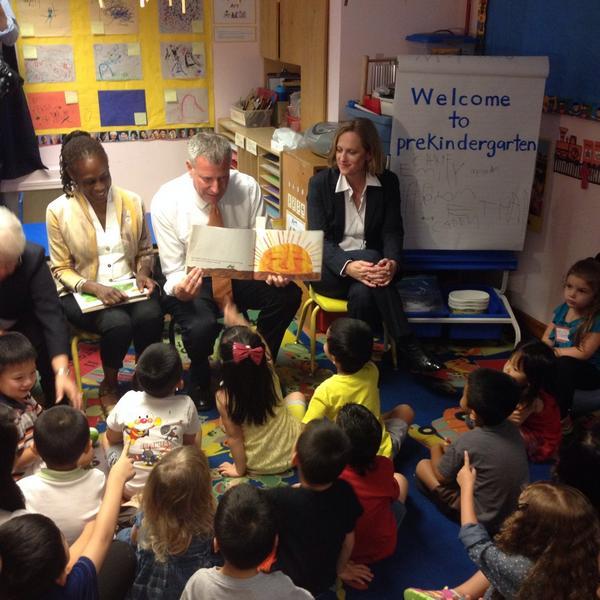
Mayor de Blasio reads to students (photo: @MelindaKatz)
The state legislature will soon decide whether to reauthorize, amend, or eliminate mayoral control of the New York City public schools. Mayoral control should be extended and, as suggested by the Mayor, made permanent - with the possibility of amendment as with any law.
The most important reason to keep mayoral control is to keep city funding of our schools at a high level. Prior to mayoral control there were incessant and critical battles over the city's underfunding of our schools. That in part resulted from the demise of the old Board of Estimate, which set the City budget, and its mirrored membership on the Board of Education, consisting of single representatives of each Borough President and 2 mayoral appointees.
Once the Board of Estimate was eliminated, the connection between operational and budgetary authority of the schools was lost. The effect was immediate and harsh. An era of underfunding ensued, propelled by a new City Charter giving the Mayor strong budgeting powers but without authority for schools. As a result, the Board of Education budget withered while mayoral agencies were privileged.
Only with mayoral control did city funding increase and increase substantially. We no longer hear cries of impoverishment over the city's education budget. The fight now is over State funding because mayoral control means more money. Pure and simple.
While adequate city funding is the main reason for retaining mayoral control, there are additional benefits. The old Board of Education was a recipe for paralysis because six appointing authorities controlled seven votes on the Board. As Board Counsel, I saw petty political horse trading, patronage, and personal ambition mean more than quality education since no one was in charge. Kids, parents, and taxpayers bore the consequences, not those who bore real responsibility. A parade of short-term Chancellors came and went, leaving a legacy of instability that subverted any stirrings of instructional success.
Mayoral control has given us continuity and stability, prerequisites for educational improvement. Despite the churn of the last decade - and my strong public opposition to Bloomberg/Klein policies - leadership stability has been a plus. (Remember the chaos of Cathie Black!) Nothing is worse for a system than constant leadership changes and mayoral control has brought surprising system stability.
And stability is good for direction. Like it or not, clear institutional direction - the ability to make and implement decisions - is another requirement of strong institutions. I know that many of my friends claim the need for "checks and balances," but public education is not a national government to be protected from extremes of political volatility. It is fundamentally an executive function, requiring the clarity of mission and organizational structure that comes from having someone in charge.
It is easy to criticize the present scheme; harder to find a practical alternative, especially under a Charter giving the Mayor such strong fiscal power. Why believe shared authority will work when it failed before? Why believe elections will make schools less political and any more stable? When Board of Education members served fixed terms, we had the ridiculous spectacle of Board appointees betraying their Borough Presidents to side with Rudy Giuliani in a political power play, resulting in the anti-Dinkins "Gang of Four." This was not about kids but personal ambition.
If we need tweaks - and I warn of opening the door to all manner of tweakers - City Council advice and consent over the Chancellor's appointment and removing the Chancellor from PEP membership would create greater community input into DOE leadership and more pluralism in PEP deliberations.
As a former President of the Citywide Council on High Schools, I see the need for greater collaboration between the DOE and parent groups at the central, district, and school levels but that requires non-legislative solutions, not more regulation.
Much of the current opposition to mayoral control is a reaction to the Bloomberg years. But we have only begun to explore the opportunities and proven strengths of the law. If mayoral control has so far not yielded school policies attractive to particular constituencies, that is not the problem of governance but those who govern. Let's not be led astray by believing our policy preferences can be guaranteed by some new structure.
***
David C. Bloomfield is Professor of Education Leadership at Brooklyn College and The CUNY Graduate Center. He is the author of American Public Education Law, 2nd edition, among other works.
***
Have an op-ed idea or submission for Gotham Gazette? E-mail editor Ben Max: This email address is being protected from spambots. You need JavaScript enabled to view it.
Responsibility for Akai Gurley's Death
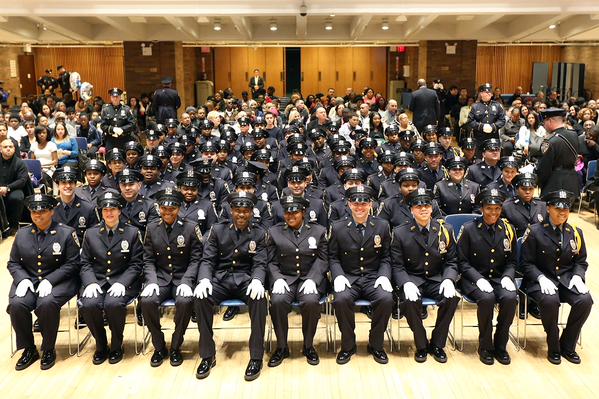
NYPD recruits (photo: @CommissBratton)
A Brooklyn grand jury recently indicted NYPD probationary Police Officer Peter Liang in the death of Akai Gurley, who was shot in a darkened public housing stairwell in November. The indictment means Liang will be brought to trial on homicide charges.
But an important question remains: is anyone else responsible for Gurley's death?
The finger of blame points at two of New York City's largest and most important agencies. First, the New York City Housing Authority (NYCHA) must bear responsibility. NYCHA knows that stairwells are crime-prone locations that require regular patrols by the NYPD. By failing to maintain a properly lit stairwell, NYCHA placed its tenants and the city's police officers at serious risk of harm.
Worse, Gurley and his girlfriend used the darkened stairs after growing tired of waiting for an elevator, which apparently wasn't working properly. Another example of the disrepair that we know plagues NYCHA buildings, yet receives too little attention.
Indeed, the darkened stairwells that were the norm at the Louis Pink Houses created a crime prone location that no doubt necessitated the NYPD conduct vertical patrols in the buildings' staircases and on its rooftops. The darkened stairwells also contributed to the practice of officers performing these vertical patrols with their guns drawn, as it appears Liang did.
Clearly, NYCHA's failure to maintain a lighted stairway created a dangerous condition for both tenants and police officers which directly contributed to Gurley's death.
The NYPD is responsible for this tragedy as well. Two inexperienced and unsupervised "rookie" officers – Liang and his partner Shaun Landau – were given the dangerous job of patrolling the stairway. The officers may very well have been inadequately trained, and they were authorized by NYPD to draw their weapons while they patrolled the unlit staircase.
It is especially troubling to consider why the NYPD assigned two rookies to conduct a vertical sweep of this housing complex. Compounding the problem, Police Commissioner William Bratton - before Gurley's death - recognized that his predecessor's practice of pairing rookies together must be changed.
Unfortunately NYPD's decision to eliminate this risky practice of teaming inexperienced officers is ending too late for Gurley and his loved ones - and for the officers involved. Perhaps if a more experienced officer had been partnered with Liang, this tragedy might have been avoided.
As Bratton publicly stated, Gurley was "a total innocent" and the shooting was "an unfortunate accident." But, the NYPD's institutional culpability must not be overlooked. Calling it "an unfortunate accident" does not absolve NYPD's managers from its responsibility.
Gurley's death – whether caused by criminal or civil negligence – is a tragedy of enormous proportions. The criminal process may bring some closure to Gurley's family and friends, notwithstanding the fact that a trial verdict is always uncertain.
In the end, two major City institutions – NYCHA and NYPD – failed Gurley and Liang.
We must not allow those in charge of NYCHA or the NYPD to hide behind "no comment" when questioned about their roles in this tragedy. Although criminal and civil matters are pending, these city officials must tell the people of New York what institutional mistakes were made and how these mistakes are being corrected.
What's needed now is the light of full disclosure. If these agencies fail to acknowledge their roles in this terrible event, further investigation by the Brooklyn District Attorney may be required.
In the realm of public accountability, there should be no darkened stairwells.
***
Arnold Kriss is a former NYPD Deputy Commissioner-Trials and Brooklyn Assistant District Attorney. He is presently a Manhattan attorney.
***
Have an op-ed idea or submission for Gotham Gazette? E-mail editor Ben Max: This email address is being protected from spambots. You need JavaScript enabled to view it.
Housing Needs Deserve Spotlight In This Year's Budget

Gov. Cuomo speaking about his 2015 agenda (photo: Kevin P. Coughlin/Office of the Governor)
Existing programs are simply not sufficient to meet the demand for more affordable homes in New York State, in large part because they do not serve people across a wide range of incomes. Budget season is the perfect time to address this problem.
Strict income restrictions coupled with limited subsidy are obstacles to many families that apply for affordable homes. A recent New York Times article highlighted the challenges faced by many – people like Leigh Lumford, a Brooklyn resident who was rejected for an affordable apartment because she surpassed the income requirement by only $3,000 a year. Narrow income ranges make it nearly impossible for many families at the middle and very low end of the income spectrum to get the help they deserve.
However, there is a lot that New York State can do to help meet the housing needs of these individuals and families. The windfall from mortgage foreclosure and other settlements is an opportunity to make affordable housing programs work better for more New Yorkers. At NYSAFAH, we are calling for this year's budget to include a new $500 million fund to encourage the development of mixed-income housing. Mixed-income development serves a broader range of people and helps foster economic diversity, spur community revitalization, and create jobs.
Hardworking individuals shouldn't be forced into long commutes and less time with their families because of a shortage of affordable, middle-income housing. Teachers, firefighters and other professionals often find they can't afford to live in the communities where they work due to a shortage of quality rental housing plaguing towns throughout the state.
Proven programs, like the State Low Income Housing Tax Credit (SLIHC), encourage private investment in affordable housing projects. Today, there is more demand for SLIHC than credits available, which means some projects that would help middle-income families are never built. The State should increase funding for SLIHC by infusing $150 million into the program to help generate capital for mixed-income projects. Unlike federal programs, SLIHC supports housing for moderate- to middle-income households earning up to 90 percent AMI, and has helped build affordable homes in every corner of the state.
The Brownfield Tax Credit program is another important driver of affordable housing development, providing much-needed resources for the remediation of environmentally contaminated areas as well as credits to build affordable housing on remediated sites. Governor Cuomo has identified affordable housing as a priority use for the program, and its reauthorization this year is essential to continue transforming vacant lots into affordable homes for New York residents.
In addition to meeting the housing needs of low-, moderate- and middle-income New Yorkers, the Governor should be commended for establishing a NY/NY IV program to provide 5,000 units of permanent supportive housing for New York's homeless population. However, only a small fraction of those in need are ever placed in a supportive housing unit, even though supportive housing saves at least $10,000 per person per year. With approximately 80,000 homeless individuals throughout the state, NYSAFAH is calling for additional funding to develop and preserve 30,000 units of supportive housing over the next 10 years.
The growing demand for more affordable and supportive housing means communities, industry members, advocates, and lawmakers must come together to forge creative, new tools to get the job done. This year's budget and the funds from settlements are a once-in-a-generation opportunity to throw our support behind programs that make a real and measurable difference in the lives of New Yorkers.
***
Jolie Milstein is President & CEO of the New York State Association for Affordable Housing (NYSAFAH), the largest trade association for the affordable housing industry statewide.
***
Have an op-ed idea or submission for Gotham Gazette? E-mail editor Ben Max: This email address is being protected from spambots. You need JavaScript enabled to view it.
New York City Students Deserve the Whole Story on Sexual Health
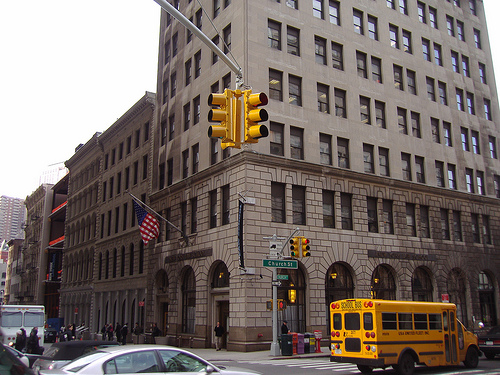
(photo: dnj_Brian via flickr)
I never thought I could get HIV. From the little I learned about HIV in high school in Far Rockaway, Queens, I thought that anyone who has it looks really sick. At school, they only showed us photos of people who looked thin and like they were dying.
In November 2012, the unthinkable happened. I was diagnosed with HIV. My heart stopped, and all I could think about was death. How could my boyfriend have had HIV? He looked so healthy. Unfortunately, my school didn't teach us the whole story about HIV - or about anything involving sexual health for that matter.
I didn't even learn about using condoms or tips for negotiating condom use with a partner. And we only learned about straight sex and didn't learn anything about LGBTQ health and sexuality. I began to feel attracted to boys at a young age, but since straight relationships were the only ones discussed in school, I felt like my feelings were not counted. I also didn't connect with the small amount of information I received about HIV since in school they only focused on straight relationships. If I had learned more, maybe I would not be HIV-positive today.
Unfortunately, many schools across New York City are still failing students when it comes to sex education. The City requires a semester of sex ed in middle school and one in high school, but that's not enough, and a lot of students still aren't receiving even that minimum amount. Connect 2 Protect (C2P) Bronx Coalition recently conducted a survey of high school students in the Bronx, and just 37 percent of them said that at school they had learned communication skills when it comes to sex. Only 47 percent had learned about condom negotiation. And only 26 percent learned about support for LGBTQ students.
This is unacceptable. If more students learned skills such as condom negotiation or protecting themselves from sexually transmitted infections, young people in New York City would be healthier. It's also important that young people learn about healthy relationships and consent. Sex ed should be comprehensive, and it should start early, in elementary school, with content that's appropriate for younger kids, and then continue through high school.
It's so important that young people learn about sexual health and relationships at school, because many kids aren't learning about this at home. My family never talked about sex, so I never brought it up with them. Plus, when I came out to my family in 10th grade, it was clear that my parents didn't want to accept that I'm gay. So I never brought up sexuality or sex again. There are many young people who can't safely or comfortably talk to their families about sex for a variety of reasons. Even if kids do learn about sex at home, it's important that it's reinforced with accurate sex ed in school.
I feel like society failed me by not making sure that every student receives honest, accurate information on sexual health and preventing sexually transmitted infections and HIV. It hurts to know that there are still young people like me in schools across the city who are not getting the information they need to protect themselves and make healthy decisions.
I talk to my friends to share the real facts about HIV. I make it clear that someone doesn't have to look sick to have HIV. In fact, HIV often has few or no symptoms for up to 10 years or more before symptoms develop. I also tell people how HIV is not spread. People who have HIV are still discriminated against, because many people still don't know the facts about HIV.
New York City schools must do more to educate students about sexual health. Every young person in the city has a right to know how to protect themselves from HIV, sexually transmitted infections, and unintended pregnancies. They also deserve to learn about consent and what constitutes a healthy relationship. Improving sex ed in city schools must be a priority, and there's no time to waste.
***
by Ernesto
***
Have an op-ed idea or submission for Gotham Gazette? E-mail editor Ben Max: This email address is being protected from spambots. You need JavaScript enabled to view it.
This Budget, Let's Make HOPE Truly Count
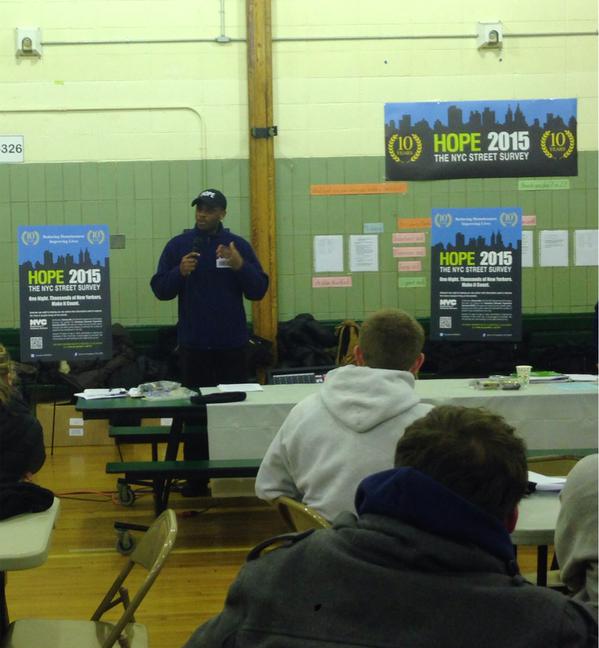
DHS Commissioner Taylor during HOPE 2015 (photo: @JennsLenz)
Last Monday night, thousands of volunteers spanned across New York City to conduct Homeless Outreach Prevention Estimate (HOPE) 2015. HOPE is the annual point-in-time count of the New York City street homeless. It enables the City to gauge the extent of street homeless in New York City – an estimated 3,357 individuals last year. HOPE also helps the City to evaluate the ongoing street homelessness work it and its nonprofit partners are doing, including outreach.
Outreach work has two components. First, workers attempt to engage the street homeless individual, who is often living with a mental illness, substance abuse issue, or severe health problem.
"You introduce yourself, give them your card and ask them if there's anything they need," says Hilton Douglas, an Urban Pathways outreach worker. "Sometimes they tell us to get out of their face, but you just have to keep engaging with them day in and day out. Other times you catch them at the right time and with the right tone, and they open up."
On day one of Port Authority Bus Terminal outreach work this past September, Urban Pathways staff engaged Mark H. His body was covered with open sores, including some on his left leg infested with maggots. When outreach approached him, he insisted he did not need help. After outreach workers found him 24 hours later, he agreed to go to the Olivieri Drop-In Center where he got a shower and new clothes and met with a nurse. He also agreed to go to the hospital where he was diagnosed as a paranoid schizophrenic.
The second important component of outreach work is placement. For Mark H, placement was a return home to his family. After initial assessment, Olivieri staff discovered he was the subject of a six-month, Ohio missing person report. Once staff contacted the local Ohio sheriff office and Mark H was stabilized, his brother came and took him home.
The placement that occurred for Mark H is infrequent though. More often, street homeless individuals are placed in drop-in centers or city single adult shelters. There, with the invaluable assistance of case managers, they stabilize and work to become housing-ready and move along the path to self-sufficiency and permanent housing.
However, many homeless adults living on the streets are unwilling to enter the city shelter system. They fear they will be victimized. Or, they may be seriously impaired due to mental illness or substance abuse and unable to commit to treatment or recovery as a condition to accessing shelter. For this chronically homeless population, the City offers safe havens, which operate using the housing first model – an approach that centers on providing the homeless with housing as quickly as possible and then providing services as needed.
Safe havens constitute a particularly viable placement option. Beside providing shelter and services, they allow for a transitional period to begin the rehabilitative process and recovery from the harshness of the streets. New York City has recognized the utility of safe havens. There are ten in four boroughs - three in the Bronx, four in Manhattan, two in Brooklyn, and one on Staten Island.
Another key service model in addressing street homelessness is supportive housing - affordable housing combined with support services tailored to individual needs. Supportive housing has proved effective. In the first five years of the most recent New York City/State supportive housing agreement, New York City chronic homelessness decreased by almost half. The utility of supportive housing, in part, stems from the stabilization it provides to those who have lived extremely unstable lives. However, there is a dearth of supportive housing in New York City. Only one supportive housing unit is available for every six eligible individuals. At least two-thirds of New York City street homeless are in need of permanent supportive housing.
As the City and State move forward in budget season, let's make HOPE truly count by adequately investing in these placement options. It is encouraging that the City will devote more resources to unsheltered homeless people this year, allocating more than $45 million in City and State funds, up from $35.5 million the year before. It is less than encouraging that the City and State have not adopted a new City/State supportive housing agreement. In particular, we call on the State, notably Governor Cuomo, to amend the proposed state budget and fully fund the State's share of a New York City/State supportive housing agreement. The time is now to account for and support all those counted during this year's HOPE and those before.
***
by Nicole Bramstedt and Erik Ipsen
Bramstedt is the Policy Analyst at Urban Pathways.
Ipsen is a member of the Board of Urban Pathways, where he has served since 2002.
***
Have an op-ed idea or submission for Gotham Gazette? E-mail editor Ben Max: This email address is being protected from spambots. You need JavaScript enabled to view it.
Moving Forward in Sunset Park
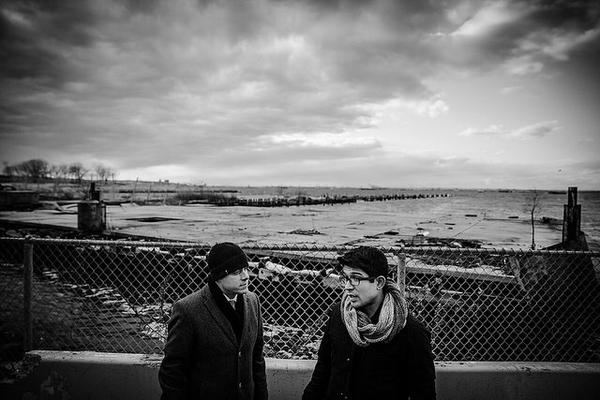
CMs Garodnick, left, and Menchaca visit the site in question (photo: William Alatriste)
Mayor Bill de Blasio's mantra around addressing the "Tale of Two Cities" that is New York particularly resonates in Sunset Park, Brooklyn. It is one of the city's few remaining industrial waterfront neighborhoods with a high concentration of working-class and poor residents, mostly immigrants from Asia and Latin America. However, the growing presence of the creative class including fashion designers and artisanal manufacturers has stirred concerns of gentrification and displacement among long-time residents and community stakeholders.
Make no mistake, Sunset Park is at a crossroads. The industrial waterfront is changing through private and public investment after long years of neglect. But if the tale of two cities is to be truly tackled, the waterfront's renaissance needs to be inclusive.
Measures must be taken to ensure that long-time residents and businesses are not forced out due to rising property values triggered by the introduction of affluent millennials as Sunset Park entrepreneurs and residents. The de Blasio Administration must recognize that creating jobs with living wages is as essential as affordable housing.
Toward that end, it might be instructive for the administration to revisit the de Blasio mayoral campaign's ideas. Mayor de Blasio was one of the few candidates to specifically articulate an industrial attraction and retention policy, doing so in a paper titled, "A Progressive Vision for Industrial Development in New York City."
Recognizing the need for blue-collar jobs and manufacturing's high annual wages in comparison to the retail or food service industries (two of the city's fastest growing job sectors), candidate de Blasio pointed to the Brooklyn Navy Yard and the Greenpoint Manufacturing Design Center as "models for non-profit industrial development" that create good jobs. In the same paper, he specifically proposed that Sunset Park's Brooklyn Army Terminal and Bush Terminal - two massive industrial sites managed by the New York City Economic Development Corporation (EDC) - "would benefit from an independent non-profit manager dedicated to strategic investment, workforce development, and reinvestment into the target area." [italics added]
Sunset Park City Council Member Carlos Menchaca seems to have read the same policy paper when he proposed the formation of such a non-profit entity to act as a steward for the South Brooklyn Marine Terminal (SBMT) rather than signing away control of the 70-plus-acre site to the EDC for the next half-century.
EDC's chief, a mayoral appointee, called off the deal claiming "it's not good public policy" in the New York Daily News and described the proposal as "confounding" in Crain's New York.
We're puzzled by the EDC's actions. We grew up in Sunset Park and our father continues to live in the same house he's called home since 1974. Both of our parents labored in industrial, manufacturing jobs. We wholeheartedly support Mayor de Blasio's commitment to ensuring that the same opportunities our family had remain available for all New Yorkers.
In his State of the City speech, Mayor de Blasio stated that "[c]reating more affordable housing; raising wages and benefits; strengthening our neighborhoods by better connecting them to jobs and opportunity—that is how we'll take on the Tale of Two Cities." Now is the time to move this vision forward and candidate de Blasio proposed a way to do so in Sunset Park.
***
by Tarry and Carl Hum
Tarry Hum is a professor at the City University of New York and author of Making a Global Immigrant Neighborhood: Brooklyn's Sunset Park
Carl Hum is a civil rights attorney in Washington D.C. and former director of the New York City Mayor's Office of Industrial and Manufacturing Businesses
***
Have an op-ed idea or submission for Gotham Gazette? E-mail editor Ben Max: This email address is being protected from spambots. You need JavaScript enabled to view it.
Labor Supports a Fair Trash Plan
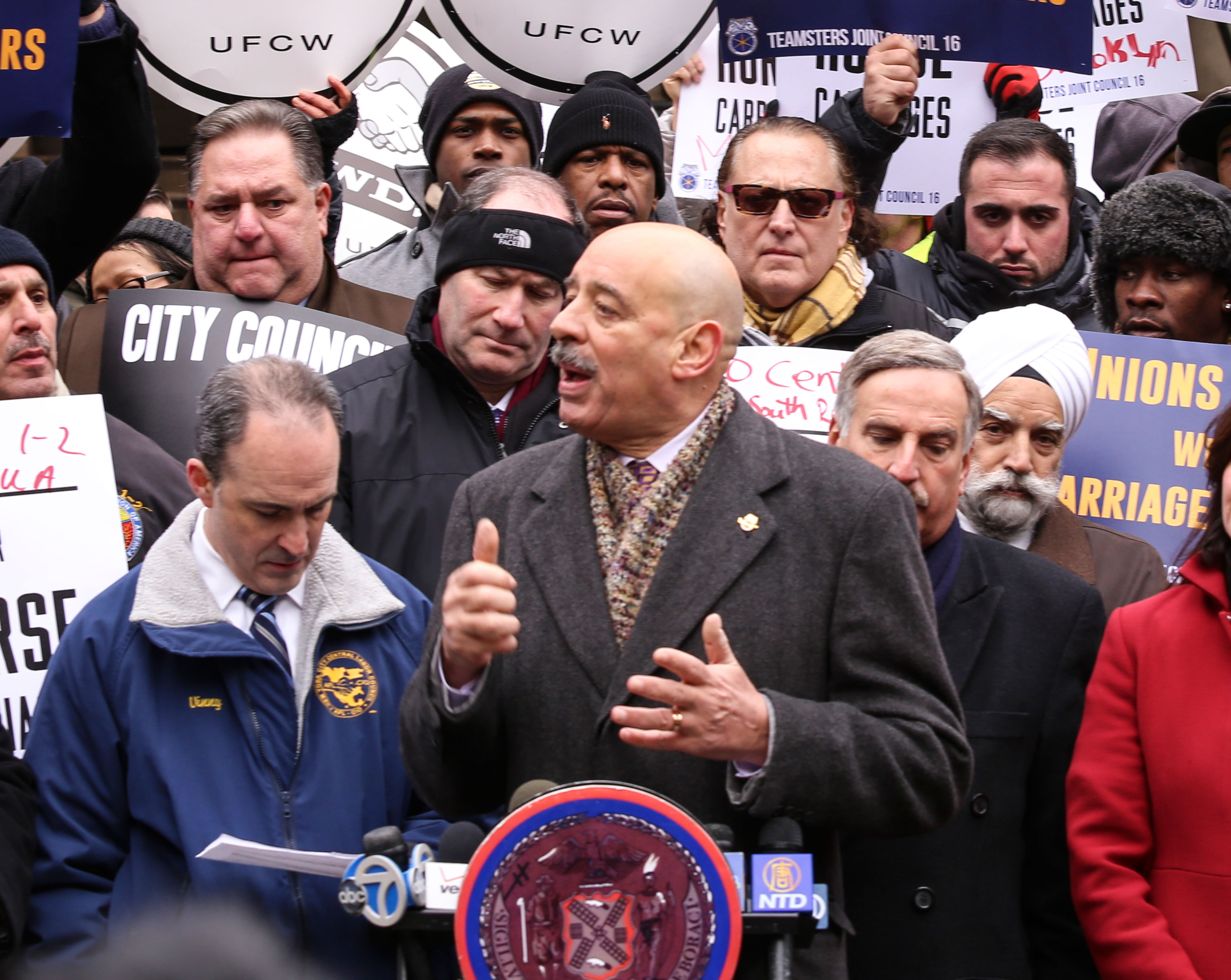
George Miranda, the author, at a rally (photo via International Brotherhood of Teamsters)
There are few things more political in New York City than garbage.
On Friday, the City Council's Sanitation Committee held a hearing on Intro. 495, legislation that will cap the amount of trash that can be sent to any one neighborhood for disposal.
It sounds simple enough and only fair. But fights between communities and big corporations, who make a lot of money hauling garbage, are rarely easy. Intro. 495 is a different story. Labor is standing shoulder-to-shoulder with these communities and holding the companies where our members work accountable.
The Teamsters are New York City's sanitation union. From the Department of Sanitation workers who pick up the trash and recycling from your home, to the private carting workers who collect and process waste from New York City businesses, we take out the trash.
In the past, unions did not see community activists as our allies – or worse, we saw them as Not-In-My-Backyarders standing in the way of jobs. I now know that these fights are our fights too. Caring about workers does not end when they clock out. If our members do not have clear air to breathe or safe streets to walk with their kids, that is a union issue.
It is also about fundamental fairness. Forcing a few neighborhoods to take almost all of the city's trash is just plain wrong.
Currently, three-quarters of New York City's trash is sent to three communities: the South Bronx, North Brooklyn, and Southeast Queens. Almost half of our city's trash comes from Manhattan, but the borough lacks a single transfer station, the facilities where garbage is dumped every day and loaded onto trucks destined for out-of-state landfills.
The Department of Sanitation plans to change that with a state-of-the-art transfer station on East 91st Street, and others around the city. Technology will control odors and pollution, and trash will be exported by barge and rail, reducing the number of trucks on our streets. The employees will join the ranks of the city's sanitation workers, Teamster members who receive good pay, benefits, and safety protections.
The South Bronx, where I grew up, is home to numerous dirty, old waste transfer stations. Every morning, long lines of private garbage trucks form in front of homes, schools, and parks, waiting to drop off their loads. The smell is even worse than the sight – garbage fumes and diesel exhaust – and the problem is more than aesthetic. Children in these communities have higher asthma rates than the city as a whole because of pollution like diesel exhaust.
It's not a coincidence that neighborhoods like the South Bronx get saddled with all of our waste. The sanitation corporations have always found it easier to operate in poor communities of color. Our city government has gone along with it.
Mayor de Blasio and the City Council can do better. Voters want elected officials who will make sure the trash gets picked up, but we also voted for a vision of one city, where the poorest and most vulnerable among us are protected.
Intro. 495 would do two things. It would reduce the amount of trash going to the three most burdened neighborhoods. They would still take more trash than anywhere else, but the impact would be lessened. This has been the goal of opening a fleet of modern transfer stations, which will soon come on line around the city, but this legislation would make it the law too.
Second, the legislation would create a cap for all communities, so that no neighborhood ever again takes more than its fair share of trash.
Intro. 495 is part of a larger movement to make a waste system that works for everyone. At the same time, we are working to increase recycling, expand composting, and raise working standards in the sanitation industry.
You might be asking yourself, why would the sanitation workers union want to reduce the amount of trash we collect? The truth is, this is an industry where becoming more efficient actually creates more and better jobs. Recycling creates five to 20 times more jobs than landfilling trash. By increasing recycling we won't just be cleaning up our communities, we will also be creating good jobs for New York families.
Less trash is better for New Yorkers, at home and at work.
***
George Miranda is President of Teamsters Joint Council 16.
***
Have an op-ed idea or submission for Gotham Gazette? E-mail editor Ben Max: This email address is being protected from spambots. You need JavaScript enabled to view it.
Pass Nicholas' Law, Increase Protection for Children from Guns
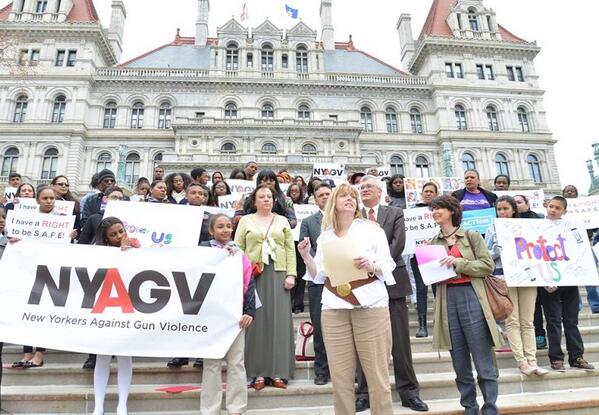
A NYAGV rally in Albany (photo: @NYAGV1)
On December 22, 2010, Oxsana Naumkin received a phone call no parent should ever get. She was told, "Nicholas has been shot." Her 12-year-old son, Nicholas, had been fatally shot while on a playdate by a friend who found his father's loaded and unlocked 9mm handgun in a dresser drawer.
The adult responsible received a $250 fine and was ordered to surrender his weapons.
According to federal data from the Centers for Disease Control, between 2007 and 2013 an average of 62 children aged 14 and under died each year in unintentional shootings. But a 2014 study by Everytown for Gun Safety shows these deaths are significantly undercounted. The study revealed that at least 100 children were killed in unintentional shootings from December 2012 to December 2013 - almost 2 children per week and 61% more than federal data show. Nearly 85% of these deaths happened in a home or vehicle belonging to the family, a friend, or relative of the victim, as in the case of Nicholas Naumkin, most often with guns that were legally owned but not locked up.
As well as being killed, children are often unintentionally injured by guns. In New York State an average of 210 children aged 19 and under are treated annually in a hospital because of an unintentional firearm injury.
Although the shooting death of Nicholas Naumkin was called an 'accident' by the media, where children and guns are involved, there is no such thing as an accident.
These deaths and injuries are preventable. We protect our children from household poisons, secure them in car seats and with seat belts, install stair guards, child-proof light sockets, and fence in our swimming pools. Shouldn't we also be concerned about a product owned by 30% of American households that was designed to kill?
Nearly two million children live with unsecured guns. In New York, 38% of gun owners reported some form of unsafe storage.
Many parents underestimate the extent to which their children know where guns are stored and how often their children handle these guns without adult supervision. A Harvard study showed that 70% of children under the age of 10 know where a parent keeps the household gun and 36% of the children reported handling the weapon.
The American Academy of Pediatrics (AAP) strongly advises homes with kids to be gun free. That's because a gun in the home is far more likely to kill someone known to the family than to kill or injure an intruder.
A gun in the home also triples the risk of homicide and increases the risk of suicide by 5 times. If parents or caregivers do own a gun, the AAP urges the adults to be responsible and lock them up, separate from the ammunition, so children can't gain access.
Unsecured guns in the home also contribute to youth suicides. Nationally, suicides in children and youth from the ages of 10–19 hit a twelve-year high in 2013. Gun suicides are now the second leading cause of death among children and teens after car deaths, replacing gun homicides. Sixteen New York children and teens committed suicide with a gun in 2013.
Educating parents about safe gun storage is important. Before they send their child to another home, parents should ask, "Is there an unlocked gun in your house?" Oxsana Naumkin is convinced had she asked this question, Nicholas may still be alive.
But safe storage laws are also important. There is strong evidence that Child Access Prevention (CAP) Laws can reduce the number of children killed or injured in unintentional shootings and significantly reduce youth suicides. CAP laws make gun owners, whose unsecured guns result in harm, subject to criminal liability.
Twenty-eight states and the District of Columbia have some form of safe storage law. Many people may be surprised to learn that New York, a state with relatively strong gun safety laws, does not have a Child Access Prevention law. Even Texas and Florida have CAP laws.
That's why New Yorkers Against Gun Violence is advocating for Nicholas' Law (A.53/S.2291), named for Nicholas Naumkin. The law would require guns not in the immediate possession of the owner to be stored in a safe or other secure container with a locking device, to prevent access by children. Gun owners who fail to comply will be subject to criminal liability ranging from a violation to a felony, depending on the harm that results.
The New York State Coalition to Prevent Child Access to Guns is calling for the enactment of Nicholas' Law and has over fifty member organizations, including the American Academy of Pediatrics, the NY State Nurses Association, the NY State PTA, the League of Women Voters, and the NY State Chapter of Moms Demand Action for Gun Sense in America.
New York must do everything it can to protect children from the dangers of unsecured guns in the home.
***
Leah Gunn Barrett is the Executive Director of New Yorkers Against Gun Violence
Sign the petition for Nicholas' Law at www.nyagv.org. Your organization can join the NY State Coalition to Prevent Child Access to Guns by emailing This email address is being protected from spambots. You need JavaScript enabled to view it.
***
Have an op-ed idea or submission for Gotham Gazette? E-mail editor Ben Max: This email address is being protected from spambots. You need JavaScript enabled to view it.
Queens Deserves Better Transportation
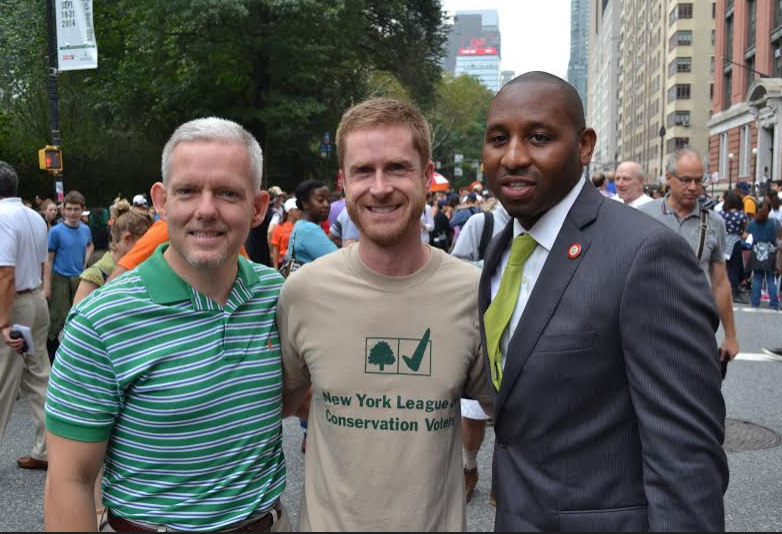
Council Members Van Bramer, left, and Rchards, right, flank an advocate
When Rockaway Peninsula's only subway connection to Manhattan – the A Train – was not in service for seven months after Hurricane Sandy, it shined a bright light on the inadequate transit options the outer boroughs rely on. The Rockaways, however, weren't just cut off from Manhattan, they were isolated from the rest of Queens.
Last year, 4.1 million people visited the Rockaways – a 25 percent increase over 2012. But the Rockaways are more than just a destination, they are a starting point for residents who travel to work, school, and doctor appointments throughout the city. As more people make their way to Queens, we stand at a pivotal juncture. Yet, we do not have the transportation infrastructure in place to support this kind of growth. From Far Rockaway and Arverne to Jackson Heights and Woodside, there is a need for something better.
In his State of the City Address, Mayor de Blasio not only outlined his support for improved public transportation, but specified the role that bus rapid transit would play in the borough of Queens.
An important step in solving the problem of inadequate transportation infrastructure is the introduction of a Select Bus Service (SBS) corridor that includes full-featured Bus Rapid Transit (BRT) where feasible along Woodhaven and Cross Bay Boulevards, extending to Far Rockaway.
SBS is designed to reduce travel time with off-board fare collection and bus lanes painted a different color than others. Full-featured BRT includes dedicated, center-median bus lanes, traffic signal prioritization, platform level boarding, and protected bus lanes - all of which cut down travel times even more than SBS. Carving out space for specific street users will not only reduce congestion, but will make boulevards safer for everyone.
The Department of Transportation (DOT) and MTA are developing a plan to improve Woodhaven and Cross Bay Boulevards for drivers, bus riders, pedestrians, and bicyclists. We are happy to hear that the DOT is planning to implement full-featured BRT where possible along the corridor and into Far Rockaway. Transportation options like BRT can make a significant, positive impact for the commuter who lives on Beach 25th and needs to get to their job at LaGuardia, the student who lives in Broad Channel and needs to get to York College for class, or the mom who needs to get from her job at Elmhurst Hospital Center to her home in Hammels in time to have dinner with her kids before they go to sleep.
Hurricane Sandy was a tragic event. Nearly two years later, we now have the chance to build a more resilient, more connected Queens. It is our hope that DOT and MTA follow through on their commitment to improve transportation along Woodhaven and Cross Bay Boulevards and in the Rockaways.
This past week the City Council's Committee on Transportation held a hearing on the state of transit where a number of our colleagues voiced their strong support for BRT and other initiatives to help move New Yorkers. We represent the length of the Queens corridor extending from the Woodside 7 Train-LIRR Station to the Far Rockaways and believe that better bus service – in the form of SBS and full-featured BRT – would provide the affordable, convenient, and reliable transportation options that our borough so desperately needs and deserves.
***
by Council Members Donovan Richards and Jimmy Van Bramer
Richards is Chair to the Committee on Environmental Protection and represents the neighborhoods of Far Rockaway, Laurelton, Springfield Gardens and Rosedale.
Van Bramer is Majority Leader and represents the neighborhoods of Astoria, Long Island City, Sunnyside and Woodside.
***
Have an op-ed idea or submission for Gotham Gazette? E-mail editor Ben Max: This email address is being protected from spambots. You need JavaScript enabled to view it.